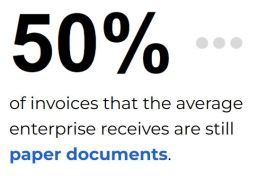78% of CFOs View AI Integration as Crucial for Accounts Payable
As businesses adapt to a digital environment, many accounts payable (AP) departments are still using outdated practices. With rising business-to-business (B2B) payment volumes and cumbersome manual systems still in place, companies are prioritizing AP automation.
A PYMNTS Intelligence report, “Automating Accounts Payable for Cost Savings,” in collaboration with Finexio, examines this shift, which enhances efficiency and security while providing insights for better decision-making.
Challenges of Outdated Systems
Many companies face hurdles due to antiquated AP processes. About half of the invoices received by the average enterprise are still paper documents, and 38% of payments are processed manually. This reliance on outdated methods is problematic as nearly 80% of businesses anticipate growth in the volume of payments made through their AP systems in the coming years. Additionally, 34% of companies manage more than 5,000 invoices each month, underscoring the need for a more streamlined approach.
To complicate matters, close to 60% of large enterprises — those with revenue between $10 billion and $20 billion — use five or more different AP systems. This fragmented tech environment can lead to inefficiencies, delays and increased risks of human error, making the case for automation more compelling.
Embracing AI for EfficiencyTo combat these inefficiencies, business leaders are turning to artificial intelligence (AI) as a solution for their AP cycles. Consider 78% of CFOs believe the integration of AI into their AP processes is important, while 73% of executives from mid-sized businesses add automation not only enhances cash flow, but also contributes to overall savings and growth. Eight-five percent of these leaders believe that AP automation leads to more accurate and efficient processes.
Third-party integrations can facilitate this transition. For instance, procure-to-pay software suites can embed additional solutions into existing workflows, streamlining the digitization of AP functions. But the journey toward automation is still in its early stages: only 17% of enterprise firms operate their source-to-pay cycles with minimal human involvement. Partnerships, such as the one between Emburse and Finexio, show a trend toward incorporating AI into AP systems, providing firms with tools to move away from manual processes.
Automation in B2B PaymentsThe advantages of automating AP processes are extensive. Companies that adopt these technologies can reduce the risks associated with fraud. According to the report, paper checks account for about 60% of fraud cases in B2B transactions. By eliminating checks, businesses can diminish their exposure to fraud; more than one-fifth of mid-sized firms expect automation to support their fraud prevention efforts.
Beyond security, AP automation enhances cash flow. About 44% of mid-sized businesses anticipate that automation will lead to cost savings and improved cash flow management. Solutions like those offered by Finexio allow firms to monetize payments, generating revenue while increasing operational efficiency.
Enhanced data analytics capabilities are also a benefit, with 53% of AP leaders emphasizing the importance of improved reporting and insights, which streamline decision-making processes.
Path Forward for APThere is a need for AP modernization. Companies that embrace automation not only stand to gain efficiencies but position themselves to thrive. Automated systems can reduce fraud, enhance cash flow, and drive in-depth analytics for decision-making.
Adopting up-to-date AP technologies is no longer optional; it is imperative for maintaining a competitive edge. The future of accounts payable depends on companies embracing automation, creating opportunities for marketplace growth.
The post 78% of CFOs View AI Integration as Crucial for Accounts Payable appeared first on PYMNTS.com.
